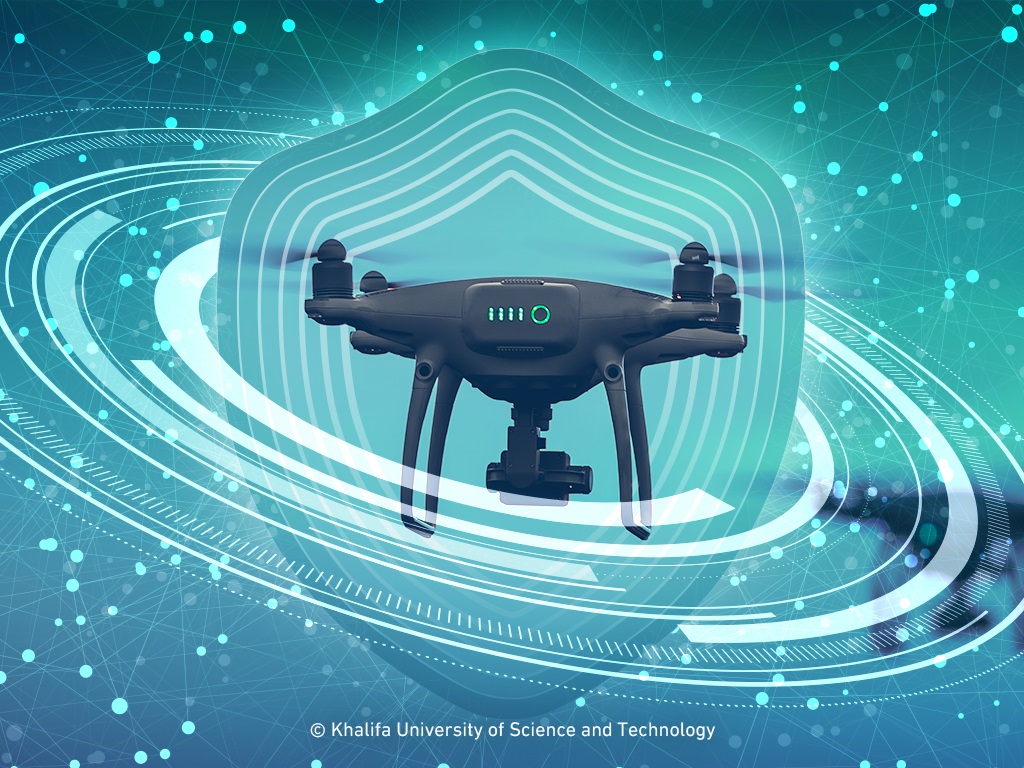
Research partners seek to deliver reliability, security to flight computer system applications
Unmanned aerial vehicles (UAVs), commonly known as drones, have multiple potential uses. To optimize their operability and efficiency, they need to be protected from hackers and must also expend minimal energy to extend their flight time. A variety of internal components tell the drone where to go, how to orient itself and how to avoid danger. However, some of these factors may be exploited to wrest control of the drone from its rightful operator.
In collaboration with the Technology Innovation Institute (TII), the applied research pillar of Abu Dhabi’s Advanced Technology Research Council (ATRC) and international partners from universities across Italy, Canada and the US, researchers at Khalifa University, led by Dr. Baker Mohammad, Professor and Director of the KU System-on-Chip Lab (SoCL), are creating a secure flight computer system to prevent external parties from attacking and taking control of drones.
The KU team, comprising Dr. Mohammad, Dr. Hani Saleh, Associate Professor, Dr. Mahmoud Al Qutayri, Professor, and Dr. Dima Kilani, are developing a system-on-chip hardware for drone flight computer applications to optimize security, resilience, power efficiency and real-time performance. In addition, their design will showcase innovative in-processor and platform design to ensure the power- and area-efficiency of the solution for use on standard and micro drones.
The team is basing its hardware on established reduced instruction set computing (RISC) architecture. This means their system will use a small, highly optimized set of instructions rather than the more specialized set often found in other types of computer architecture. Based on open source RISC-V, this architecture allows the research team to achieve at least 10 times greater efficiency and performance when compared to existing commercial systems.
Once the computer architecture is developed, the team plans to scale it down to serve heavily power-constrained applications such as flight computers for nano drones.
A smaller device will further mitigate the cost and integration issues often seen in large power-hungry and expensive systems. Owing to its enhanced computing capabilities, this device will also enable drones to tackle the most demanding advanced flight control tasks and connectivity management functions, such as drone-to-drone and drone-to-cloud communication.
“A key objective of the project is to co-design software and hardware to achieve a strong Trusted Computing Base (TCB) for the flight controller and drone connectivity platform,” Dr. Mohammad said. “The TCB is designed to ensure that the hardware and software components work together to provide security guarantees. Our approach to the design will be based on the Kerckhoffs’ principle, which states that the TCB of a security system should be publicly known and transparent except with regard to the cryptographic keys. Therefore, even if an attacker knows everything about the operation of the TCB, they still cannot break the system unless they are familiar with the keys.”
Once these parameters are assured, the designed computer architecture can deliver security and reliability in real-time while addressing the power efficiency requirements.
The project also has the ambitious goal of exploring the combination of security and safety features to ensure a truly reliable and flexible flight control platform for unmanned aerial vehicles well capable of withstanding intentional attacks as well as unintentional faults emerging from a harsh operating environment. This is one of many projects currently underway as part of the multi-year collaboration between KU and TII and is set to pave the way for future synergies.
Speaking on the collaboration, Dr. Shreekant Thakkar, Chief Researcher at TII’s SSRC, said, “SSRC is focused on developing and applying innovative security technologies to protect potentially vulnerable systems in our increasingly connected world, where cyber threat levels continue to surge every day. Through our collaboration with our international partners, we target one order of magnitude improvements in performance and efficiency with respect to current flight computer systems. In the context of commercial solutions, we hope to deliver the reliability and security requirements flight computer system applications urgently need today.”
Jade Sterling
Science Writer
9 August 2021






